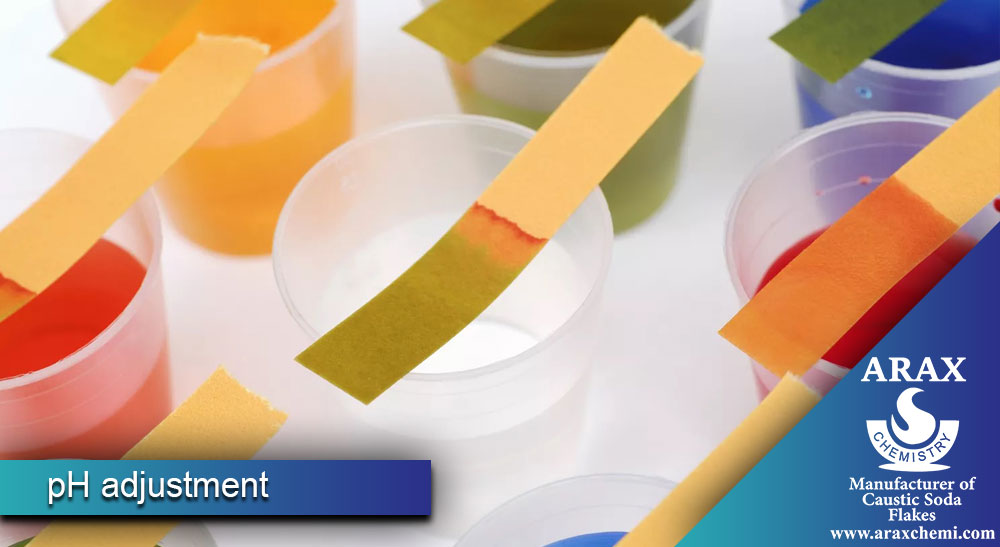Oil refining is a vital process in the oil and gas industry, which is performed to separate and purify various compounds resulting from crude oil extraction. In this process, caustic soda (sodium hydroxide) is used as an important chemical. Caustic soda plays an important role in oil refining with high pH balancing properties. With the ability to balance the pH of different solutions and fluids, this material can have a significant effect on the separation and cleaning of various compounds. Also, by neutralizing acidic compounds and pH balance of solutions, caustic soda can help improve the quality and efficiency of oil refining processes.
The use of caustic soda in oil refining is done for many reasons, but it is necessary to adjust its usage amounts and usage conditions properly to reduce side effects and undesirable problems in the oil refining process.
What is oil?

Oil is a complex mixture of hydrocarbons that forms naturally in the underground. This mixture consists mainly of aliphatic hydrocarbons (compounds containing only hydrogen and carbon atoms). Oil includes organic and inorganic compounds that can be extracted in liquid form under natural conditions.
The main compounds found in oil.
Hydrocarbons
They are the main constituents of oil. These hydrocarbons may be in the form of chains such as octane, decane and alkanes. Among the known examples of hydrocarbons, we can mention methane, ethane, propane, butane, hexane and naphtha.
Organic compounds
In addition to hydrocarbons, oil also contains other organic compounds. These compounds include derivatives of elements such as oxygen, sulfur, nitrogen and metals. For example, organic compounds in petroleum include aromatic hydrocarbons such as benzene and toluene, alcohols, aldehydes, ketones, and acids.
Inorganic compounds
Oil can contain inorganic compounds such as sulfur, nitrogen, oxygen and metals. These compounds can be present as complex organics or as mineral salts.
Oil compositions are highly variable and its exact composition depends on factors such as oil source, reservoir rock, geographical area and geographical conditions and time of oil formation. For this reason, oil compositions may be different in different regions of the world.
The process of using caustic soda in oil refining

The process of using caustic soda in oil refining is usually done in the form of a process called “soap formation”. In this process, caustic soda is used as a base to neutralize the acidic compounds in the oil and improve the pH balance. Below, the general steps of the process of using caustic soda in oil refining are explained:
Preparation of caustic soda solution
At first, the caustic soda solution is prepared with suitable ingredients including water and caustic soda. This solution usually dissolves a certain percentage of caustic soda in water.
Mix with oil
Caustic soda solution is added to crude oil and mediators such as mechanical ester (mechanical mixer) are used to mix these two materials well.
Neutralization of acidic compounds
As a base, caustic soda reacts with acidic compounds in oil and neutralizes them. This reaction leads to the formation of organic soaps similar to those used in the washing process.
Separation of soaps
The soaps formed in liquid form are in the oil. At this stage, the soaps are separated from the oil and can be easily separated.
Adsorption of pollutants
Soaps, which contain organic compounds and pollutants, are able to absorb pollutants in oil. In this way, the pollutants are absorbed as a solution in the soap and separated from the oil.
Separation steps
After adsorption of contaminants, separation steps such as sedimentation, centrifugation, and filtration may be used to separate soaps and adsorbed contaminants from oil.
Using caustic soda in oil refining improves the properties of oil. This process leads to the reduction of oil acidity, the removal of organic and inorganic pollutants, the improvement of oil and water separation ability, the control of decay and the prevention of oil pH reduction.
The method of using caustic soda in oil refining
There are several methods for using caustic soda in oil refining. Below are some common ways to use caustic soda in oil refining:

(Saponification)
This method includes steps in which, in response to pH changes, acidic compounds in oil react with caustic soda and organic soaps are formed. These soaps can absorb pollutants and be separated in the next steps.
(Neutralization)
In this method, caustic soda is used as a base to neutralize the acidic compounds in the oil. By adding caustic soda to oil, acidic compounds such as acid and naphthones are neutralized and the pH of the oil is improved.
(Adsorption)
In this method, caustic soda is used as an absorbent. Caustic soda is able to absorb organic and inorganic pollutants in oil. These pollutants can be dissolved in soaps and caustic soda separates the pollutants from the oil by absorbing them.
(Emulsion Breaking)
In some cases, oil may be emulsified with water, resulting in an oil-water emulsion. Using caustic soda as a neutralizing agent can help break down this emulsion and separate oil and water.
(Desalting)
In the dewatering process, caustic soda is used as a caustic agent to neutralize the welding and chlorides in the water contained in the oil. This process helps to separate oil and water and improves the quality of oil.
The effect of caustic soda in oil refining
Neutralization of acidic compounds
Caustic soda acts as a strong base and neutralizes the acidic compounds in the oil. These acidic compounds may be pollutants, sulphide pollutants and acidifiers. By neutralizing these acidic compounds, the properties of pollutants change and the processes of oil separation and purification are improved.
Separation of water and oil
Caustic soda is used in the desalting process. Water in oil may contain mineral salts such as chlorides and welds. By adding caustic soda to oil, the salts in water are neutralized and the separation of water and oil is improved.
Emulsion breakdown
In some cases, oil and water can mix together in an emulsion state and form an oil-water emulsion. Caustic soda is used as a neutralizing agent to break the emulsion and separate the water from the oil. By breaking down the emulsion, it will be easier to separate water and oil.
Adsorption of pollutants
Caustic soda also acts as an absorbent. This substance is able to absorb organic and inorganic pollutants in oil. Contaminants may be dissolved in soaps, and by absorbing them, caustic soda separates the contaminants from the oil and improves the quality of the oil.
These effects are just a few of the effects of caustic soda in oil refining. In each specific oil refining process, the use of caustic soda may be used according to specific needs and can have other effects.
Disadvantages and advantages of using caustic soda in oil refining
The use of caustic soda in oil refining has certain advantages and disadvantages. Below, we examine the advantages and disadvantages of using caustic soda in oil refining:
Advantages
- Neutralization of acid compounds: Caustic soda can neutralize acid compounds in oil. This action improves the properties of oil and facilitates the separation and purification processes.
- Oil and water separation: Using caustic soda in the desalting process can neutralize the salts in water and improve oil and water separation.
- Emulsion breaking: Caustic soda is used as a neutralizing agent to break the oil-water emulsion and separate the water from the oil. This improvement in the separation of water and oil leads to an improvement in the performance of the purification system.
- Absorption of pollutants: caustic soda is able to absorb organic and inorganic pollutants in oil and improve the quality of oil.
Disadvantages
- Energy consumption: Using caustic soda may require energy consumption to prepare and mix it.
- Effect on pH: The use of caustic soda in large quantities can cause significant changes in the pH of oil. These changes may need to be adjusted to be compatible with other petroleum refining processes.

- Adverse effects on the environment: The use of caustic soda may lead to the creation of effluents that require proper management and disposal. Also, it should be considered that this material may have side effects on the environment.
- Changes in oil properties: Using caustic soda may cause changes in oil properties. Therefore, the proper selection and use of caustic soda should be done carefully in order to maximize the target properties of oil refining.
last word
caustic soda is a chemical substance capable of absorbing and removing pollutants in the oil refining process, which can significantly improve the efficiency and quality of oil refining due to its special characteristics. Therefore, the use of soda ash has been proposed as an effective and efficient alternative to oil refining processes. According to the studies, the use of caustic soda in oil refining has significant advantages and results. This substance is able to separate organic and inorganic pollutants from oil and improve the qualitative properties of oil. By absorbing the pollutants and solids in the oil, Perak Sod can help in the final refining of the oil and improve the quality of the final products. In addition, the use of perk interest also leads to other benefits. This material can be recycled and reused, which means saving resources and reducing the waste of natural resources. Also, as a sustainable method, soda ash has less environmental impact than traditional oil refining methods.
